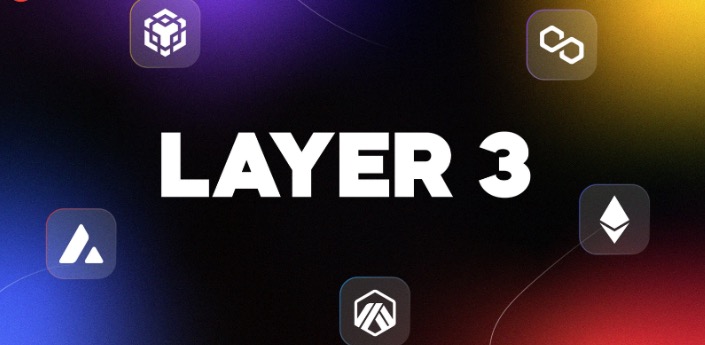
Understanding the Rise of Layer3 Networks through the Hot Trend of DEGEN Chain|TrendX Research Institute
Data on April 1st shows that in the past 24 hours alone, L3 chain Degen Chain has already had over 27,200 independent transactions, with a transaction volume close to 100 million US dollars, and a peak price of over 0.06 US dollars within the day. DEGEN has seen a more than 40-fold increase in the past half month. The market value of the Degen project has also surpassed 1 billion US dollars in just three months, and its platform Farcaster is breaking user activity records, showing its rapid growth momentum, signaling the market's increasing excitement for L3 networks such as DEGEN Chain.
However, while the market is excited about L3 networks, this phenomenon has also sparked continuous community controversy. Marc Boiron, CEO of Polygon Labs, expressed his dissatisfaction with Layer3 (L3) networks, stating that their existence is taking away the value of Ethereum. This viewpoint was also supported by Mert Mumtaz, CEO of Helus Labs, who believes that L3 is essentially centralized servers and positions them as other centralized servers (L2) controlled by multisigs.
With the popularity and influence of Degen Chain, the narrative of L3 networks has gained enough attention on the stage. This article will focus on Layer3 networks, from basic concept popularization, to DEGEN's successful analysis, and then share several excellent well-known Layer3 projects, to jointly explore this blue ocean full of opportunities.
Development History of Blockchain Network Solutions
Before understanding Layer3 networks, it is very important to understand Layer1 and Layer2 blockchains.
Layer1 refers to the base layer of the blockchain network. Some common examples of Layer1 include Bitcoin chain, BSC chain, and Ethereum chain. Layer1 blockchain networks provide the basic infrastructure for developing dApps, where developers can create layers for transaction settlement and verification for smart contracts, dApps, and other blockchain layers. Another important highlight of Layer1 blockchain is that they do not rely on any other network. With projects like rain after a drought on Layer1, the network cannot handle the increasing execution and computation brought by the rapid development of the ecosystem, resulting in high transaction costs to complete transactions in a congested public chain environment, leading to the emergence of Layer2 under the banner of reducing fees and scaling.

Layer2 networks are a key part of the development of blockchain and Web3. Some common examples of Layer2 include Arbitrum, Optimism, Polygon, etc. The basic optimization logic of Layer2 is to separate the public chain's functions and layer them, leaving the consensus mechanism that provides security on Layer1, and pushing computation and execution down to Layer2, making the public chain the settlement layer of Layer2, which is easier to implement and operate compared to cross-chain and sharding mechanisms. While maintaining a decentralized model, Layer2 maximizes operational efficiency, but still lacks in highly customized application scenarios and interoperability between protocols, which is the opportunity for the emergence of Layer3.
The Layer3 expansion solution is an upgrade and improvement from Layer2, and when Ethereum founder Vitalik talked about the practical application of Layer3, he summarized, "L2 is used for scaling, L3 is used for customizable scaling, which precisely matches the special scenarios used by users and the application direction preferred by developers. At the same time, L3 has weak trust expansion characteristics, leaving data availability to trusted third parties or committees, further ensuring user privacy and usage security." In addition, Layer2 solutions cannot promote communication between different protocols. Users seeking interoperable protocols and cross-chain dApps can seamlessly move within the entire decentralized service environment. The application scenarios of Layer3 solutions are clear, and the demand is urgent.

The Rise of L3 Chain DEGEN
Degen was launched on the Degen channel on Farcaster in January 2024, distributing tokens between builders, content creators, and users. It reshaped the Farcaster ecosystem, allowing Casters to use DEGEN tokens to reward high-quality content creators. As of April 1st, DEGEN tokens have over 83,000 holders, over 553,000 transactions, and are still growing rapidly.
DEGEN Chain is a customized L3 for the Degen community, allowing new attempts in tipping, community rewards, payments, games, etc. Its behind-the-scenes team is Syndicate, who have collaborated with multiple vendors such as Conduit, Decent, and Airstack to improve convolution, bridging, and data API. It is an L3 built using Arbitrum Orbit, settled using Base, and provides data availability using Arbitrum AnyTrust, ensuring low cost and scalability. This effort marks an important step for EVM-compatible Layer3 solutions, aiming to expand the scope of community rewards, tips, and payments. It is worth mentioning that the uniqueness of DEGEN Chain lies in the fact that the DEGEN token is also the native Gas token of the chain, making it a pioneer among community tokens with its own L3.
Unique factors of the rise:
-
Innovative airdrop and tipping mechanism: DEGEN Chain introduces a unique airdrop gameplay, distributing tipping amounts based on user activity and participation, incentivizing users to create and share high-quality content, while also promoting the circulation and value growth of DEGEN tokens. Since January, Degen has rapidly gained popularity in the Farcaster community through high-quality tipping activities, where community members can reward their favorite high-quality content with a combination of comment count + DEGEN. The airdrop amount is based on the total amount received from others' tips, so users need to post good content on Farcaster to receive tips, and many active users' daily tipping amounts even reach thousands of US dollars.
-
Community-driven development: DEGEN Chain originated from the Farcaster community, and the active participation of this community has provided a solid foundation for DEGEN Chain. Community members use DEGEN tokens to reward high-quality content creators, greatly enhancing the cohesion and activity of the community.
-
Diversified application scenarios: DEGEN Chain is not limited to a single application, but through cooperation with multiple projects and DApps, such as Drakula, DegenCast, etc., it has expanded the application scenarios of its tokens. This diversified strategy gives DEGEN tokens a place in different platforms and applications, increasing their utility and attractiveness.
The decentralized TikTok on Base chain, Dracula, was launched on March 14th, and the app uses DEGEN tokens as tokens, allowing users to purchase their favorite bloggers with DEGEN tokens, adding scenarios and value to the application of DEGEN tokens.
-
Angel round financing brings financial support: In February, Degen announced the completion of a 490.5 ETH (approximately 1.47 million US dollars) angel round financing, which will be used for the development of the Degen ecosystem and community. Some shares were given to some community projects, such as Drakula, laying the groundwork for Degen's utility.
-
Unique market positioning: DEGEN Chain is positioned as a paradise for meme coins and experimental projects, making it stand out in the cryptocurrency field. It not only provides a testing ground for emerging projects, but also offers high-risk, high-return investment opportunities for investors.

DEGEN Chain ecosystem:
With its community-first approach and innovative Layer3 blockchain technology, DEGEN Chain has quickly emerged as a vibrant and rapidly expanding platform within the Farcaster ecosystem. In just the first week of its launch, developers have launched multiple applications on DEGEN Chain, with the most notable being:
-
DegenSwap: DegenSwap is the primary decentralized exchange on DEGEN Chain, providing convenience for the trading and exchange of various cryptocurrencies, playing a crucial role in the liquidity and user participation in the ecosystem.
-
Memecoins: The popularity of various Memecoins such as $CET, $DINU, $PURP, etc., has soared. These tokens have not only attracted attention, but also encouraged more users to bridge with the Degen chain, promoting its active market activities.
Degen Chain is rapidly developing into the Las Vegas of the chain, providing a sandbox for cryptocurrency developers to explore community participation through tipping, rewards, and games.
Sharing Well-Known Layer3 Projects
- StarkWare Appchains:
It is StarkWare's Layer3 solution, and StarkWare is a pioneer in Layer2 solutions.
StarkWare Appchains provide high customization, allowing developers to choose different consensus mechanisms, data availability models, network configurations, fee mechanisms, and even issue their own tokens for fees. By using Appchains, dApps can achieve better performance and cost-effectiveness on Starknet. Appchains allow for optimized performance, increased throughput, and provide powerful custom solutions for decentralized applications. They can also achieve lower transaction costs and larger scale, providing a better user experience.

Related link:
https://app.trendx.tech/project/b3d1b7b9127814e0a648bb431ed75e8ad46b5a03fa613d5fd53ea0897438f039
- Nautilus Chain:
It is a public chain launched by the Zebec community and is considered one of the latest Layer3 system architectures in the industry. With support from Layer0 facilities such as Celestia and Eclipse, Nautilus Chain aims to provide parallel, high-speed EVM Rollup scaling solutions. Features of Nautilus Chain include modular chain design and enhanced privacy through ZK Rollup technology. The project also plans to launch global activities to promote the popularization of Layer3 concepts and attract developer participation.

Related link:
https://app.trendx.tech/project/710943a47cc850940d1f28f4bfc404d7db5014c65d611fe7a32db8e6e4baf640
- Arbitrum Orbit: It is a framework within the Arbitrum ecosystem that allows development teams to create and launch their own dedicated chains, which can be Layer2 or Layer3 chains, and settle them on Arbitrum's Layer2 chains, such as Arbitrum One, Arbitrum Nova, or Arbitrum Goerli.
Arbitrum Orbit provides unparalleled customization capabilities, allowing developers to customize their gas tokens, privacy settings, permission controls, etc., according to the specific needs of their projects. The Orbit chain uses the Arbitrum Nitro technology stack, which is the most advanced blockchain scaling technology currently, and can benefit from future upgrades of the Nitro technology stack, including performance optimization, permissionless verification, and Arbitrum Stylus.

Related link:
https://app.trendx.tech/project/9785883aeab585b9d12f9b24a06e1418ea0c08e0bf72582dbc2b598ddbe1f3aa
- zkSync HyperChain: zkSync is a Layer2 solution based on zero-knowledge proofs, and HyperChain is its proposed Layer3 solution. zkSync HyperChain utilizes zero-knowledge proofs (ZKP), an encryption method that allows one party (prover) to prove to another party (verifier) that a statement is correct without revealing any information about the proof process. Unlike other solutions, zkSync HyperChain can inherit the complete security of Ethereum, as it uses ZK-rollups technology. This means that all transaction data will be verified on the Ethereum main chain, ensuring the same level of security as Ethereum. The goal of zkSync HyperChain is to achieve super scalability, handling an infinite number of transactions without marginal impact on security or cost.
Related link:
https://app.trendx.tech/project/3ec8ac45896ea13bc6929b44f2a9d9e0712057d1201823df5ec764c320054179
- DappLink: This is a general Layer3 technology solution, adopting a modular plug-and-play design that supports different module plugins for social games, DeFi, etc. This design allows for the launch of different Layer3 modules according to different application scenarios, meeting specific needs. The core technologies of DappLink include cross-chain interoperability protocols, Layer3 reverse staking protocols, and Layer3 App Chain. The cross-chain interoperability protocol supports a wide ecosystem, allowing assets to be transferred between different chains; the Layer3 reverse staking protocol ensures the operation and security of the Layer3 AppChain node network.
Related link:
https://bridge.dapplink.xyz/home
These projects are just a small part of the Layer3 field, and there are many other projects exploring and developing. With the development of blockchain technology and changes in market demand, we can expect to see more Layer3 projects in the future to meet the needs of different industries and application scenarios. The emergence and development of Layer3 projects signify the progress of blockchain technology in addressing scalability, cost, and security issues, and the emergence of new things always comes with controversy and questioning, but it cannot be denied that this also further promotes the maturity and prosperity of the Web3 ecosystem.
Follow Us TrendX
TrendX is a leading AI-driven Web3 trend tracking and intelligent trading platform globally, aiming to be the preferred platform for the next billion users entering the Web3 field. By combining multidimensional trend tracking and intelligent trading, TrendX provides a comprehensive experience of project discovery, trend analysis, primary investment, and secondary trading.
Website: https://app.trendx.tech/
Twitter: https://twitter.com/TrendX_tech
Investment carries risks, projects are for reference only, please bear the risks on your own



